
|
Sale 72
February 2-5. 2013
| Finest Buffalo Nickel Collection we have ever handled |
| |
| |
| Lot |
Photo |
Description |
Realized |
Lot 1142 |
 |
1873. Closed 3. PCGS graded MS-65 PQ. Well struck and mostly untoned. This is a lovely, radiant Gem, both sides being essentially brilliant with frosty, silver-nickel white luster. Judged from an aesthetic standpoint, the coin is also possessed of a much finer strike than is typically found for a shield nickel struck in the early 1870s. Pop 18; 3 finer in 66 (PCGS # 3801) .
Estimated Value $1,200 - 1,300.
View details and enlarged photos
Check results on similar lots
| Realized
$2,588 |
Lot 1143 |
 |
1876. NGC graded MS-65. CAC Approved. A nice untoned well struck coin.Centennial year issue. Pop 35; 7 finer.
Estimated Value $900 - 1,000.
View details and enlarged photos
| Realized
$1,438 |
Lot 1144 |
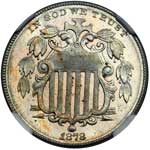 |
1878. NGC graded Proof 64. Mostly untoned. Only 2,350 minted and well-placed for the collector who wants a low-mintage date (there were no circulation strike 1878 Shield Nickels made, only Proofs this year). Scarce.
Estimated Value $1,500 - 1,600.
View details and enlarged photos
| Unsold |
Lot 1145 |
 |
1880. NGC graded Proof 66. A beautiful untoned coin, bold and of the ideal Gem quality for the Shield Nickel connoisseur. Only 3,955 minted. Pop 139; 35 finer.
Estimated Value $700 - 750.
View details and enlarged photos
| Realized
$776 |
Lot 1146 |
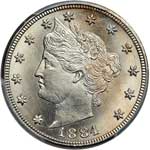 |
1884. PCGS graded MS-65. A blazing frosty untoned gem, sharply impressed by the dies and gleaming with originality. Scarce in this grade: Pop 70; 25 finer (PCGS # 3845) .
Estimated Value $1,100 - 1,200.
View details and enlarged photos
Check results on similar lots
| Realized
$1,553 |
Lot 1147 |
|
A Nice Group of Liberty Nickels 1883 to 1912. Includes: 1883 No Cents (226), 1883 With Cents (47), partial set of Nickels (1 set), mixed date Liberty Nickels (77). The coins will grade Poor to XF .
Estimated Value $1,000-UP.
View details
| Realized
$1,438 |
Lot 1148 |
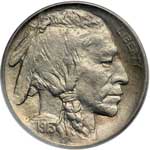 |
1913. Type 1. PCGS graded Proof 65. Housed in an Old Green Holder. Boldly struck and mostly untoned. Only 1,520 minted. Satiny golden gray with grand overall eye appeal. All devices were struck with such force and determination by the specially made Proof dies that elements show with razor-edge intensity.
The matte Proof nickels of 1913-16 were usually sold as part of the so-called "silver Proof set." Collectors had another option, however, the "minor Proof set," consisting of the cent and nickel alone. This cost all of 15 cents. These options account for the fact that Proof totals for each year are not consistent from one denomination to the next. The coins were presented to their purchasers in folded tissue paper. The tissues are the bane of today�s collectors, as their high sulfur content caused the coins stored in them to develop irregular and sometimes unattractive toning. The Proof nickels of 1936 and 1937 were, like other denominations, sold individually. The cost of a Proof buffalo nickel from these years had risen to 20 cents, plus 8 cents for postage. 1936 & 1937 were delivered in cellophane bags or sleeves, folded and stapled at their open end. The toning effects that could result from such storage were still unpredictable, but their progress was usually much slower. Nice, original Proof nickels of 1936-37 are more readily available than those of 1913-16, hence the often wide price difference (PCGS # 3988) .
Estimated Value $2,600 - 2,700.
View details and enlarged photos
Check results on similar lots
| Realized
$3,795 |
Lot 1149 |
 |
1913. Type 1. PCGS graded MS-65. CAC Approved. Housed in a First Generation Holder. Deeply toned and well struck, this Gem Mint State coin exemplifies the Type 1 issue in all its beauty (PCGS # 3915) .
Estimated Value $150 - 160.
View details and enlarged photos
Check results on similar lots
| Realized
$259 |
Lot 1150 |
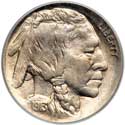 |
1913-D. Type 1. PCGS graded MS-65. CAC Approved PQ. Housed in an Old Green Holder. Lovely rich even gold toning on both sides. Boldly struck and choice with luster a-plenty (PCGS # 3916) .
At the time these were first issued in early 1913 it was too early yet to judge the full effects of this coin�s main defect, but there is no doubt that the Mint had made every effort to produce a magisterial design. The lid came off when these reached circulation and people began to notice that the denomination FIVE CENTS wore away quickly. All the talented minds at the mint soon devised an effective solution. This was to sink the words deeper into the body of the design. It enabled the nearby rim of the coin to provide the denomination better protection against abrasion in circulation and solved the problem. The first years mintage consists of six separate issues: Type 1 1913-P,D,S and Type 2 (with sunken denomination) 1913-P,D,S.
Estimated Value $400 - 450.
View details and enlarged photos
Check results on similar lots
| Realized
$719 |
Lot 1151 |
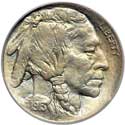 |
1913-S. Type 1. PCGS graded MS-65. CAC Approved PQ. Lovely green and gold toning on both sides. Somewhat soft strike on the reverse at "Five Cents." The balance is boldly struck. As with many first-year issues, the 1913-S was produced in fairly substantial numbers; in this case 2.1 million pieces were struck. While not rare in the absolute sense, it is, nevertheless a worthwhile Type 1 issue in high grades (especially when compared to the 1913-P) and a moderate condition rarity (PCGS # 3917) .
James Earle Fraser had made numerous studies of Native Americans before undertaking the task of creating an Indian head for the nickel. The obverse portrays a mature warrior facing right. His hair is braided in the style of the plains Indians with a ribbon securing the braid. Two feathers are affixed near the part of the hair, and a third one is only partly visible. The garment across his shoulder provides a foundation for the coin�s date, and Fraser�s initial letter �F� appears below the date. On both the original model and the struck coin, the subject appears to be in a contemplative state with eyes half closed, in the eyes of researcher David Lange.
Estimated Value $600 - 650.
View details and enlarged photos
Check results on similar lots
| Realized
$834 |
Lot 1152 |
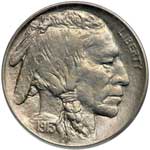 |
1913. Type 2. PCGS graded Proof 65. CAC Approved PQ. Housed in an Old Green Holder. Only 1,514 minted. A hint of light tone. Lustrous, mint-original satin surfaces put on a show with their delicate overlay of toning. The overall appearance is greatly reinforced by extra crisp detail on all relief portions, result of using specially made dies and striking the Proofs on the mint�s medal press to insure proper sharpness and eveness of strike on all design features (PCGS # 3990) .
Estimated Value $2,000 - 2,100.
View details and enlarged photos
Check results on similar lots
| Realized
$2,300 |
Lot 1153 |
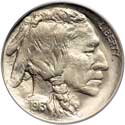 |
1913. Type 2. PCGS graded MS-65. CAC Approved PQ. Well struck with even light toning on both sides. A few minute flyspecks seen with a 5x glass (PCGS # 3921) .
Estimated Value $375 - 400.
View details and enlarged photos
Check results on similar lots
| Realized
$719 |
Lot 1154 |
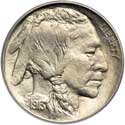 |
1913-D. Type 2. PCGS graded MS-65. CAC Approved. Housed in an Old Green Holder. Even light natural toning on both sides. Boldly struck with splendid luster. Some minute flyspecks seen with a 5x glass.
The changeover to the Type 2 reverse was ordered on May 6, 1913, and coinage of the revised nickels commenced four days later. The placing of the value FIVE CENTS within an exergue was accompanied by a smoothing of the rough textured fields that had been so widely admired on the Type 1 issue. As a result, the luster on Mint State examples is more apt to be satiny than the shimmering luster characteristic of Type 1 nickels. These changes to the fields were made deliberately by U.S. Mint Chief Engraver Charles Barber. Pop 136; 62 finer, 1 in 65+, 51 in 66, 10 in 67 (PCGS # 3922) .
Estimated Value $1,000 - 1,100.
View details and enlarged photos
Check results on similar lots
| Realized
$1,725 |
Lot 1155 |
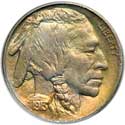 |
1913-S. Type 2. PCGS graded MS-65. CAC Approved PQ. Housed in an Old Green Holder. Lovely rose and gold toning on both sides. No flyspecks on this coin. Well struck. A truly great coin!
Years ago before emphasis was so strong on Premium Quality grades, the 1913-S Type II was recognized as one of the key dates in the Buffalo series, scarce in any and all grades from well worn to Uncirculated. Today in 2013 the coin is, of course, very elusive in Gem Mint State 65 as offered here, but also maintains its basic or foundational rarity, although sometimes this is overlooked. This is one of the nicer 1913-S Type II MS65-class nickels we have ever seen. Pop 100; 32 finer, 28 in 66, 1 in 66+, 3 in 67 (PCGS # 3923) .
Estimated Value $4,500 - 5,000.
View details and enlarged photos
Check results on similar lots
| Realized
$5,750 |
Lot 1156 |
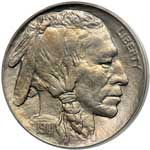 |
1914. PCGS graded Proof 65. CAC Approved PQ. Lightly toned and boldly struck. Only 1,275 minted. A hard to believe array of important features on this Gem includes the following: the surface, pristine; natural color, all original and complementing its satiny luster; and an especially bold strike which every interested collector with a magnifying glass will marvel at. In short, a first-rate Gem Proof (PCGS # 3991) .
Estimated Value $1,800 - 1,900.
View details and enlarged photos
Check results on similar lots
| Realized
$2,530 |
Lot 1157 |
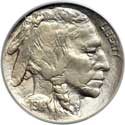 |
1914. PCGS graded MS-65. CAC Approved PQ. Lovely light blue natural toning. Well struck without any flyspecks. A nice Premium Quality coin. Note: The date 1914 is in higher relief than on the 1913 nickels, evidence that the Mint was already aware of that feature�s inclination to wear, possibly having learned from the difficulty surrounding the denomination FIVE CENTS the year before (PCGS # 3924) .
Estimated Value $500 - 550.
View details and enlarged photos
Check results on similar lots
| Unsold |
Lot 1158 |
 |
1914, 4 over 3. PCGS graded MS-65. CAC Approved PQ. A hint of light tone on both sides. No flyspecks on this coin. The best example we have ever seen. Here is one of the most memorable examples of this famous overdate extant. It is lightly toned in a beautiful, nicely balanced combination of diaphanous gold over resilient silvery nickel luster, which serves to highlight very choice, virtually flawless surfaces. Much glittering mint luster is seen on, within, and throughout the devices and fields. The strike is reasonably sharp given the worn condition of the dies. Since the discovery of the variety in 1937, a number have come to light in all grade levels, though usually circulated, while Gem quality specimens are exceedingly rare. Once this specimen is sold, it may be years before another of its caliber is available. The opportunity to include a superlative example in the ultimate PCGS Registry set of Buffalo Nickels is now.
Writing in 2000, David W. Lange reports that the Mint used at least two different obverse dies in the production of 1914/3 Nickels. One obverse displays a series of horizontal die scratches (as made) above the date. Lange suggests that these die scratches may have been from the efforts of Mint employees to efface the remaining features of the 3 underdigit. Pop 2; 2 finer in 66 (PCGS # 93924) .
Estimated Value $25,000 - 30,000.
View details and enlarged photos
Check results on similar lots
| Realized
$32,200 |
Lot 1159 |
 |
1914-D. PCGS graded MS-65. CAC Approved. Well struck with even light toning. Only a few minor flyspecks seen. As often seen on examples of this early D-mint Buffalo Nickel, this PCGS certified Gem is pleasingly sharp in strike. The luster is full, vibrant, and softly frosted in sheen. Pop 156; 47 finer, 2 in 65+, 40 in 66, 5 in 67 (PCGS # 3925) .
Estimated Value $1,300 - 1,400.
View details and enlarged photos
Check results on similar lots
| Realized
$2,013 |
Lot 1160 |
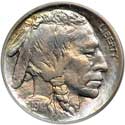 |
1914-S. PCGS graded MS-65. CAC Approved. Housed in an Old Green Holder. With a mintage approaching 3.5 million coins, the 1914-S Buffalo nickel is neither a scarce nor a rare date, but truly pleasing Choice to Gem Mint State examples are extremely difficult to locate. Wonderful pastel shades of toning enliven the obverse, the dancing luster imparting even more lovely iridescence to the color. Any numismatist who thinks that all '14-S nickels come softly struck has never seen this remarkable gem. Well struck without any visible spots. Pop 113; 29 finer, 26 in 66, 3 in 66+ (PCGS # 3926) .
Estimated Value $2,000 - 2,200.
View details and enlarged photos
Check results on similar lots
| Realized
$4,255 |
Lot 1161 |
 |
1915. PCGS graded Proof 65 PQ CAC Approved Gold Sticker. Housed in an Old Green Holder. Only 1,050 struck. Lovely golden toning. A near perfect coin.
Proof coins of the Indian head/buffalo nickel type were struck for sale to collectors from 1913 through 1916 and again in 1936 and 1937 The Proof five-cent pieces of 1913-16 are normally referred to as "matte" Proofs, but this term is misleading. True matte Proofs have a dullish finish completely dissimilar to the surfaces of normal circulation strikes, and this technique of Proofing was used by the Mint exclusively for its gold coinage of 1908 and 1911-15, as well as for isolated issues of later years that were not sold publicly (commemorative half dollars).
The Proof nickels of 1913-16, like the cents of those years, actually possess a satin finish. This varies in texture slightly from one date to the next and even within a single year�s coinage. When found pristine, these coins are extremely beautiful and visibly distinctive from currency strikes (PCGS # 3992) .
Estimated Value $2,000 - 2,200.
View details and enlarged photos
Check results on similar lots
| Realized
$3,450 |
Lot 1162 |
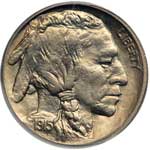 |
1915. PCGS graded MS-65. CAC Approved PQ. Housed in an Old Green Holder. Light even toning on both sides. Boldly struck with perhaps two minor flyspecks visible with a 5x glass. A wonderful MS65 "PQ" coin (PCGS # 3927) .
Estimated Value $350 - 400.
View details and enlarged photos
Check results on similar lots
| Realized
$546 |
Lot 1163 |
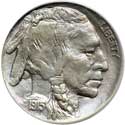 |
1915-D. PCGS graded MS-65. CAC Approved PQ. Lovely blue and lilac toning. No visible spots. A gorgeous gem of the optimum, hand-picked order for a 15-D. The extremely lustrous surfaces show supporting mint frost throughout. Agreeably well struck to say the least, indeed entirely so, enough to merit a strong bid. Pop 133; 32 finer, 30 in 66, 2 in 67 (PCGS # 3928) .
Estimated Value $1,800 - 2,000.
View details and enlarged photos
Check results on similar lots
| Realized
$2,875 |
Lot 1164 |
 |
1915-S. PCGS graded MS-65. CAC Approved. Housed in a First Generation Holder. Lovely green toning and boldly struck. A resolute gem with highly concentrated luster and almost ostentatious eye appeal from the color. Don't even try to find weakness at the Indian or on bison's shoulder, head or tail as typically seen, for this piece stands far ahead of most others of its year and has been weighed carefully by the strict grading standard for MS65. Pop 108; 31 finer, 28 in 66, 3 in 67 (PCGS # 3929) .
Estimated Value $2,800 - 3,000.
View details and enlarged photos
Check results on similar lots
| Realized
$4,025 |
Lot 1165 |
 |
1916. PCGS graded Proof 65. CAC Approved PQ. Housed in an Old Green Holder. A hint of light golden tone and boldly struck. Only 600 struck. A satiny gem of the most advantageous order for a Buffalo Nickel collector. Its high degree of smooth satin-like luster pulses beneath pale bands of golden color. Bold strike, as expected, with razor-sharpness at all the usual Achilles' heel places on the design such as the Indian�s hair, braid and feathers, and on the reverse, the bison�s head, horn, shoulder area and tail. Spot-free originality in a Gem Matte Proof 1916 (PCGS # 3993) .
Historic Account: Not surprisingly, given their low mintage, the 1916 Proofs are the rarest of the early period Proof buffalo nickels. Some portion of the 600 pieces coined was almost certainly consigned to oblivion when the Mint ceased sales of Proof coins at the end of this year.
Traditionally, Proof coins were made available for sale in January, suggesting that they may have been the very first coins struck at the Philadelphia Mint each year. Collectors had come to count on this fact and were disappointed when the delivery of Proof coins for 1915 and 1916 was held up without explanation. While the Mint awaited the new models for the dime, quarter dollar and half dollar, it was reluctant to produce any silver pieces of the old types. Delays in adoption of the new models eventually forced production of Barber Dimes and Quarters beginning in the summer, but the Mint still declined to strike Proofs of these pieces dated 1916. Ultimately, the only Proof coins made for sale in 1916 were the cent and five-cent piece.
Estimated Value $3,000 - 3,200.
View details and enlarged photos
Check results on similar lots
| Realized
$4,140 |
Lot 1166 |
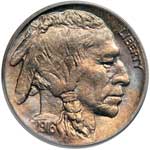 |
1916. PCGS graded MS-65. CAC Approved PQ. Housed in an Old Green Holder. Lovely rich golden toning. Boldly struck and very attractive (PCGS # 3930) .
Estimated Value $350 - 400.
View details and enlarged photos
Check results on similar lots
| Realized
$391 |
Lot 1167 |
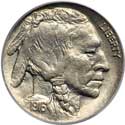 |
1916-D. PCGS graded MS-65. CAC Approved PQ. Lovely light golden toning on both sides. Well struck with no flyspecks visible. Wonderful lustrous surfaces are flourishing with nickel-fresh brilliance. Although the Five-cent coin�s alloy is 75% copper and 25% nickel, nickel being the dominant metal, imparts its color and luster to the struck coin. Impressive for the date, with all reverse details present and sharp, anyone who views it can see that "full strike" can be said. Fully struck coins of this date are elusive. Pop 112; 14 finer, 1 in 65+, 11 in 66, 1 in 66+ (PCGS # 3932) .
Estimated Value $1,800 - 2,000.
View details and enlarged photos
Check results on similar lots
| Realized
$4,025 |
Lot 1168 |
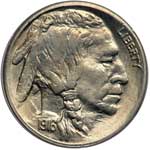 |
1916-S. PCGS graded MS-65. CAC Approved PQ. Housed in a First Generation Holder. Light hint of gold toning on both sides. Well struck and eye-catching. An impressive gem with brilliant luster under the pale color plus gleaming highlights. Representative strike for the date, which is sharp throughout the head and shoulder area of the reverse, and also finely detailed on the Indian�s features, hair braid, feathers, and date.
The Mint finally addressed some of the buffalo nickel�s basic deficiencies beginning this year. A new obverse hub was used exclusively for 1916 and all subsequent dates. The word LIBERTY was more deeply incised, eliminating its tendency to blend with the coin�s field. Proofs struck at Philadelphia, which had been made since 1913, ended their short run with the 1916 release. Pop 84; 33 finer, 28 in 66, 1 in 66+, 4 in 67 (PCGS # 3933) .
Estimated Value $2,000 - 2,100.
View details and enlarged photos
Check results on similar lots
| Realized
$4,370 |
Lot 1169 |
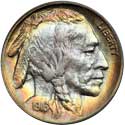 |
1916. Doubled Die Obverse. PCGS graded MS-64. Very clear overdate. Rainbow toning on both sides. Boldly struck with no visible flyspecks. Last sold in a January 2009 F.U.N. sale conducted by Heritage Auctions, "1916 5C Doubled Die Obverse MS64 PCGS. FS-101, FS-106. While certain older references describe this legendary Buffalo nickel variety as a "doubled date" variant, the source of the doubling is not from repunching, as likely would have been the case were this a 19th century piece, but is the result of hub doubling. The nature of the doubling is Class V, or Pivoted Hub Doubling, in John Wexler's taxonomy. To quote The Authoritative Reference on Buffalo Nickels, written by Wexler, Ron Pope, and Kevin Flynn, �Pivot hub doubling occurs when a die is pivoted about a point near the rim during rehubbing. Because the point of the pivot is near the rim, the spread of doubling will be the strongest at the point directly opposite the pivot point and will decrease as you move away from that point.�"
"In the case of the 1916 Doubled Die Obverse nickel, that pivot point is somewhere between 1 and 2 o'clock on the obverse, within the letters of LIBERTY. As a consequence, that word shows no doubling to the unaided eye, being too close to the pivot to show anything but a microscopic spread. Moving away from that particular area, however, doubling is widespread across the rest of the devices, from a small shift visible at the Indian's brow and lips (most examples show doubling below the nose as well, though this piece does not, likely due to die polishing), to more dramatic doubling on the feathers and braid. The most dramatic doubling of all appears directly across from the pivot point; happily for this variety, that area contains the digits of the date and the lower hair ribbons, both of which exhibit the characteristically bold doubling that has attracted collectors since the variety became widely publicized in the mid- to late 1970s. Wexler et al. note that the 1916 Doubled Die Obverse variety " … actually has a wider spread on the date than the 1955 Lincoln cent doubled die obverse."
"The 1916 Doubled Die Obverse nickel is coveted by collectors, almost regardless of condition, since it rates as a URS-9 according to most sources, with between 126 and 250 pieces known. Even low-grade pieces with the date completely worn away, identified by the residual doubling on the hair ribbons, command substantial sums. (Such a state is more common than one might think; the date, exposed as it was at the base of the portrait, wore quickly. A similar, contemporaneous occurrence took place with the Standing Liberty quarter.)
"Naturally, as grade increases, so does rarity and price. Lower and mid-range circulated pieces appear in the numismatic marketplace with some frequency, but they are ready sellers, whether in dealers' cases or on the auction block. Extremely Fine and About Uncirculated coins are borderline condition rarities. Regarding Mint State examples, David Lange's The Complete Guide to Buffalo Nickels notes that as of 2006, "Mint state examples of this variety are extremely rare and number fewer than ten."
"Since then, a handful of other certification events have appeared in the combined certified population, but whether these represent new discoveries is open to question. Even after decades of intense searching, only a handful of unworn 1916 Doubled Die Obverse nickels have turned up, and the likelihood of previously unknown survivors turning up decreases with each passing year. Neither NGC nor PCGS has certified an example of this variety finer than MS64, with NGC acknowledging five pieces and PCGS grading just two (11/08). Heritage sold the first of the PCGS coins at their September 2005 Long Beach auction, and with the arrival of this piece, we shall have had the privilege of offering the best MS64 coin known to that service."
We can say unhesitatingly the present MS64 is beautifully toned with the central areas lovely nickel-blue while colorful yellow, gold-orange, peach, and rose shades adorn the margins. The obverse even has a trace of pale green at the rims; on the reverse, the discriminating numismatist will be able to make out pale golden-brown traces over the buffalo. Lustrous with few flaws overall, though small, abrasions are seen on the Indian�s nose and in the hair above and to the left of the braid. Magnificent eye appeal, and certainly deserving of a coin that has few contenders in its grade class! Pop 3; none finer at PCGS (PCGS # 3931) .
Estimated Value $250,000 - 275,000.
View details and enlarged photos
Check results on similar lots
| Unsold |
Lot 1170 |
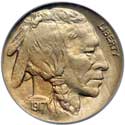 |
1917. PCGS graded MS-65. CAC Approved PQ. Even toning on both sides. Boldly struck with no flyspecks visible. There is little to say about the surfaces of this Gem coin as they are as near to pristine as imaginable for MS65 quality. The mint frost is thick and radiates intensely over each side. There is just a bit of light patina present as well (PCGS # 3934) .
Estimated Value $500 - 550.
View details and enlarged photos
Check results on similar lots
| Unsold |
Lot 1171 |
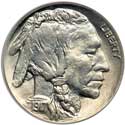 |
1917-D. PCGS graded MS-65. CAC Approved PQ. Lovely light golden toning. Well struck with no visible flyspecks. For the date, a frosty, satiny pale golden gem with deep cartwheel luster on both sides. Attractively struck as well, with just outstanding detail at the Indian�s hair and braid, the buffalo�s shaggy mane, hind quarters, head and horn.
The reverse of James Earle Fraser�s Five-cent piece is memorable in its profile view of a bison bull. In recalling this particular work, Fraser spoke of its unique character: "My first objective was to produce a coin which was truly American, and that could not be confused with the currency of any other country. I made sure, therefore, to use none of the attributes that other nations had used in the past. And, in my search for symbols, I found no motif within the boundaries of the United States so distinctive as the American buffalo." Pop 132; 14 finer, 1 in 65+, 13 in 66 (PCGS # 3935) .
Estimated Value $2,200 - 2,500.
View details and enlarged photos
Check results on similar lots
| Realized
$9,775 |
Lot 1172 |
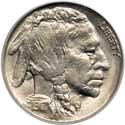 |
1917-S. PCGS graded MS-65. CAC Approved PQ. Lovely rich golden toning. Boldly struck. Some minor flyspecks visible with a 5x glass. A glistening gem with luster that practically flies off the surface. Subtle hints of champagne to deeper amber toning bring to life the expansiveness of the strike while it enhances the unexpectedly beautiful eye appeal of this elusive 1917-S specimen. It is safe to say that the greater part of the 4.1 million Nickels struck in the San Francisco Mint in 1917 went into circulation and remained there until worn or lost. The low census confirms this: Pop 79; 23 finer, 1 in 65+, 22 in 66 (PCGS # 3936) .
It appears that even the artist who designed this piece, James Earle Fraser, preferred the familiar term "buffalo" to the more zoologically correct bison. Semantics aside, the model for the nickel�s reverse is known to have been a bull named Black Diamond. This animal was then a resident of New York City�s Central Park Zoo and was already about seventeen years old at the time. Fraser�s own correspondence reveals his exasperation in attempting to keep this beast posed in profile as depicted on the coin. Evidently quite uncooperative, it insisted on confronting the artist head on and would return to this stance immediately after being corrected.
Black Diamond has occasionally been cited as the model for the $10 United States Note of 1901, the so-called "buffalo bill." This attribution is incorrect, as the greenback actually portrays Pablo, a star attraction at the National Zoo in Washington, D.C. This mistaken identity is understandable, as the $10 note was in use alongside the nickel through the late 1920s. See David Lange�s articles and book for more extensive history on the fascinating Buffalo nickel.
Estimated Value $4,000 - 4,500.
View details and enlarged photos
Check results on similar lots
| Realized
$5,060 |
Lot 1173 |
 |
1918. PCGS graded MS-65. CAC Approved. Mostly untoned. A vibrant and highly lustrous Gem 1918-P whose rush of brilliance shows this has exquisitely preserved surfaces. Struck with methodical precision throughout. Pop 180; 54 finer, 2 in 65+, 45 in 66, 7 in 67 (PCGS # 3937) .
Estimated Value $1,100 - 1,200.
View details and enlarged photos
Check results on similar lots
| Realized
$1,438 |
Lot 1174 |
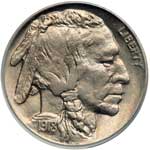 |
1918-D. PCGS graded MS-65. CAC Approved PQ. Housed in an Old Green Holder. Lightly toned and well struck for this date. An original mintage of 8.3 million pieces suggests that the 1918-D is not among the rarest issues in this series, at least in the worn grades. However, the 1918-D is particularly rare at the finer Mint State levels with a sharply executed strike. With snappy-looking definition in all areas, this important example is just such Gem MS65. To put it succinctly, there are no areas of bothersome weakness on either side. The detail is sharp. The mostly brilliant luster has a light overlay of patina. In brief, a fully lustrous, originally preserved example for the high-grade Buffalo Nickel collector. Pop 67; 24 finer, 1 in 65+, 22 in 66, 1 in 67 (PCGS # 3938) .
The Palmer Raids: The climate of repression established during World War One continued after the war ended: this time, government interest focused on communists, Bolsheviks and "reds" generally, similar to today's War on Terror. The climactic phase of this anti communist crusade occurred during the "Palmer Raids" of 1918-1921. A. Mitchell Palmer, President Wilson's Attorney General, believed communism was "eating its way into the homes of the American workman." In his essay "The Case Against the Reds," Palmer charged that "tongues of revolutionary heat were licking the alters of the churches, leaping into the belfry of the school bell, crawling into the sacred corners of American homes, seeking to replace marriage vows with libertine laws, burning up the foundations of society." Colorful language aside, with a broad base of popular support, in 1918-19 Palmer intensified the attacks on political dissent that had begun during the war.
Estimated Value $3,300 - 3,500.
View details and enlarged photos
Check results on similar lots
| Realized
$5,290 |
Lot 1175 |
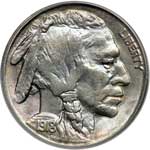 |
1918-S. PCGS graded MS-65. CAC Approved PQ. Light toning and well struck. Among the Finest Known. The only S-mint dates in this period given a higher rating by the PCGS Registry in terms or rarity in this grade are 1920-S and 1926-S.
The coin acquired by our consignor for his set, and the one on offer here, is a wonderful example that proves every rule has its exceptions. A satiny gem with energetic fresh luster and glistening surfaces that seems to want to motivate bidders to increase their bids as though by subtle hypnotism! With its superb luster, delicate patina, and relative absence of contact, this piece deservedly merits PCGS designation for aesthetic appeal. Even this piece, however, is not free of the difficulties Some planchet roughness occurs around the Indian�s head. The metal flow lines on the reverse, however, are point to better die condition and are evidence of the sharp blow the coin received from the dies. This sharp detail gives the coin much more character than competing specimens (few though they are), adds mightily to the tremendous appeal. Pop 31; 1 finer in 66 (PCGS # 3940) .
Estimated Value $20,000 - 25,000.
Ex: McCarroll Collection.
View details and enlarged photos
Check results on similar lots
| Unsold |
Lot 1176 |
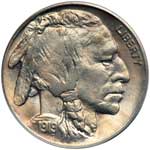 |
1919. PCGS graded MS-65. CAC Approved PQ. Housed in an Old Green Holder. A hint of gold tone. Well struck, the luster enfolds itself around the sharp main devices (PCGS # 3941) .
Estimated Value $500 - 550.
View details and enlarged photos
Check results on similar lots
| Realized
$1,006 |
Lot 1177 |
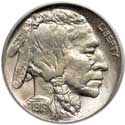 |
1919-D. PCGS graded MS-65. CAC Approved. Lovely natural toning on both sides. Better than average strike for this date. Very few flyspecks seen with a 5x glass. The end of World War I saw a drastic reduction in Nickel production at both the Denver and San Francisco Mints in 1919 after far higher numbers in 1916-17. In terms of the Denver Mint�s production, the total number of coins delivered that year amounted to a little over 8 million pieces. This mintage, together with wide circulation, explains the reason the 1919-D is scarce in all but the lowest grades. Further, the '19-D is also one of the more challenging Buffalo Nickels to locate with any degree of boldness to the striking detail. Our offering of this sharp-looking Gem, therefore, represents an opportunity of profound value for collectors who dedicate themselves to this series.
The strike is almost certainly the fullest that one can realistically expect to encounter on a 1919-D Nickel. All design elements are sharply delineated, and there are no areas of bothersome incompleteness of detail on either side. The surfaces are fully lustrous and satiny beneath a delicate overlay of golden iridescence. There are no distracting abrasions to report, and a few trivial speckles which we note solely for the sake of accuracy. A beautiful coin in all regards, and one that is seemingly destined for inclusion in another Buffalo Nickel Registry Set. Pop 53; 19 finer, 4 in 65+, 15 in 66 (PCGS # 3942) .
Events of 1919: Alexander Graham Bell, inventor of the Telephone in 1876, spent the years 1906-1921 on, among other things, development of the hydrofoil boat. His HD-4, powered by two aerial propellers, set a world�s marine speed record of 70.86 miles per hour on September 9, 1919, a record that stood for ten years.
Estimated Value $6,000 - 6,500.
View details and enlarged photos
Check results on similar lots
| Realized
$18,975 |
Lot 1178 |
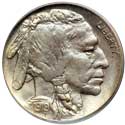 |
1919-S. PCGS graded MS-65. CAC Approved. Housed in an Old Green Holder. Lovely blue and golden toning. Nice luster on both sides. A better than average strike. Clear mint mark. The increase of worn Nickel dies in the San Francisco Mint during the late 1910s--and the lack of inhibition among employees at that facility from using those dies--explain why the 1919-S is one of the most poorly produced issues in the Buffalo series, quality control at this mint lagged far behind the production standards of Philadelphia. The reverse is typically much more softly defined than the obverse, and both the central highpoints and the peripheral devices can be affected by this feature.
A superior-quality example in all regards, this outstanding Gem belongs in the finest Buffalo Nickel set. A date where low-population statistics rule, the strike on the reverse is well above average, and we note only trivial softness of detail to the bison's head and shoulder, as well as at the tops of UNITED STATES above. Even so, the overall appearance on that side of the coin is surprisingly bold, while the obverse is even sharper. Satiny luster is really vibrant--another notable feature for what tends to be a dullish issue�further, there are no distracting abrasions or other blemishes. A virtually brilliant offering for the quality-conscious Buffalo Nickel collector. Pop 31; 3 finer in 66 (PCGS # 3943) .
Monetary history of the period: The money supply in the U.S. doubled in WWI (1914-18), and prices doubled as well. The incoming administration of 1919 decided upon the same policy as 1866-1879, withdrawing the war-created money from circulation and restoring prices to their pre-war level. Since these fine gentlemen (for the most part) were "cigar-filled-room" types and since cigars had gone from 5¢ to 10¢ during the war, they expressed this by saying "What the country needs is a good 5¢ cigar." They won the election of 1920 and were able to help bring wholesale prices down (with a big assist from natural market forces) in two stages, 1921 and 1930-33. By 1933, prices in the U.S. were back to their level of 1914, which in fact was the same price level that Daniel Webster had noted for Boston in 1815 and which had prevailed over the country in 1793--140 years of relative price stability.
Estimated Value $12,000 - 13,000.
View details and enlarged photos
Check results on similar lots
| Realized
$16,675 |
Lot 1179 |
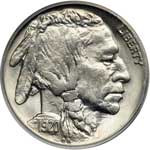 |
1920. PCGS graded MS-65. CAC Approved PQ. Housed in an Old Green Holder. Untoned and well struck, a sparkling Gem. A few minute flyspecks visible with a 5x glass (PCGS # 3944) .
Estimated Value $700 - 750.
View details and enlarged photos
Check results on similar lots
| Realized
$863 |
Lot 1180 |
 |
1920-D. PCGS graded MS-65. CAC Approved. Housed in an Old Green Holder. Lovely toning. Better than average strike. To collectors familiar with this Five-cent series, the 1918-S Buffalo is one of the most difficult to find in Choice to Gem condition, indeed, among the more elusive S-mint dates from the teens. Strikes tended to be somewhat blurred. This occurred when the San Francisco Mint overworked its dies, leaving them in the presses well past the time they had begun to show wear and deterioration. Hence, any surviving Gems are from an elect few that were saved at the time, either by accident or through the activities of devoted coin collectors.
It is striking deficiencies, rather than overall rarity, that explains the elusiveness of the 1920-D in Gem grades. The example that we are offering here is far superior to others in that is was well impressed by the dies and somehow (no one knows just how at this distance in time) survived better than 98% of 1920-D nickels known to collectors. We do, however, note some softness of detail over the central highpoints on both sides, such as the Indian�s braid and the two feathers, as well as the bison's head on the reverse. This feature, however, is marginal for the issue, and its effect on the overall desirability of this coin is immeasurably improved by the gleaming fresh luster. Both sides boast outstanding mint bloom with a satiny texture, and there are no out of the ordinary blemishes. Golden toned, this is a coin whose importance should be obvious to advanced Buffalo Nickel specialists. Pop 62; 4 finer, 1 in 65+, 3 in 66 (PCGS # 3945) .
Estimated Value $5,000 - 5,500.
View details and enlarged photos
Check results on similar lots
| Realized
$11,500 |
Lot 1181 |
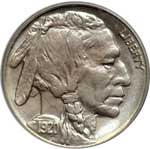 |
1920-S. PCGS graded MS-65. CAC Approved. Housed in an Old Green Holder. Lovely even lavender toning on both sides. Lots of mint luster evident. No flyspecks visible. Satiny surfaces display a sheen of lovely pale iridescence. Well above average for the date where strike is concerned, indeed, the term "razor-sharp" wouldn�t be objected to by most observers. Perhaps one of the finest 1920-S strikes currently available for sale. All the main design details are present, and are strong in all in places. David Lange referred to this date's striking qualities and rarity in his reference by noting "These are almost always quite weakly struck on the reverse. Adequate strikes do turn up, however, and are worth one's patience. In Mint State, the 1920-S is among the scarcest coins in the series. Gems are very rare." Worth ones patience. This is the defining moment for any advanced buyer of rare, high-quality Buffalo nickels. Fortunately for our bidders, the present coin is a gem with a strike that is well above average. For good measure we will note that PCGS has certified just 17 examples of the date, and one at a higher grade. What more can we say? Pop 17; 1 finer in 66 (PCGS # 3946) .
The reverse of James Earle Fraser�s five-cent piece is memorable in its profile view of a bison bull. In recalling this particular work, Fraser spoke of its unique character: "My first objective was to produce a coin which was truly American, and that could not be confused with the currency of any other country. I made sure, therefore, to use none of the attributes that other nations had used in the past. And, in my search for symbols, I found no motif within the boundaries of the United States so distinctive as the American buffalo." (For a detailed account of this fascinating coin, see David W. Lange�s The Complete Guide to Buffalo Nickels.
Estimated Value $25,000 - 30,000.
View details and enlarged photos
Check results on similar lots
| Realized
$31,050 |
Lot 1182 |
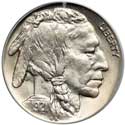 |
1921. PCGS graded MS-65. CAC Approved PQ. Well struck and mostly untoned. Free of any carbon spots. Milky white surfaces swirl with luster. A blazing Gem! (PCGS # 3947) .
Estimated Value $700 - 800.
View details and enlarged photos
Check results on similar lots
| Realized
$920 |
Lot 1183 |
 |
1921-S. PCGS graded MS-65. CAC Approved PQ. Housed in an Old Green Holder. Lovely golden toning and well struck. A key date. A resplendent gem by any standard, the luster is not in the least timid or yielding on this important San Francisco mint strike, while natural toning hues blossom on both sides. The strike, like the luster, is confident, indeed, as bold as ever seen on virtually any date in the 1920s. This decade in particular saw its fair share of poor strikes. Full, bold transfer from the die to planchet seen in the horn, tail, shoulder hair, and (on the obverse) throughout the Indian�s lower hair and hair braid. Pop 59; 8 finer in 66 (PCGS # 3948) .
The minting of all coins save for the newly mandated silver dollars was down in 1921, due to a short but severe recession which set in following the end of the World War. Nearly all 1921 coins from the three mints were struck in the early months. After that, the demand for additional circulation strikes ended; the massive quantities issued 1916-20 were more than sufficient to meet the reduced requirements of the post-war economy. With very few collectors actively seeking branch mint U.S. coins in this period, very few 1921-S nickel Five-cent pieces were saved at the time of issue. Most got into circulation.
Estimated Value $8,000 - 8,500.
View details and enlarged photos
Check results on similar lots
| Realized
$9,488 |
Lot 1184 |
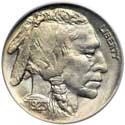 |
1923. PCGS graded MS-65. CAC Approved PQ. Lovely toning and well struck. No spots seen. Fully brilliant, the surfaces display few noticeable abrasions. A Gem BU coin that stands like a salient fortress in the midst of an advancing legion of inferior specimens (PCGS # 3949) .
Estimated Value $600 - 650.
View details and enlarged photos
Check results on similar lots
| Realized
$690 |
Lot 1185 |
 |
1923-S. PCGS graded MS-65 PQ. Housed in an Old Green Holder. Lovely golden toning. Well struck and should be graded MS66. No spots on this coin. To see this coin is to admire it deeply, and to consider its intrinsic worth is tantamount to making this a "must have" piece for the specialist. To begin with among an elite few graded at PCGS with just higher. Aspects as striking, attractiveness of toning, and overall eye appeal are not part of the number. Thus, it could just be that this is among very loveliest 1923-S Buffalo nickels on the market today.
That said, the coin is further described as being well struck, entirely lustrous, and with light patina as described evenly dispersed on both sides. Among the marvelous gems in this collection, this is certainly one of the more important S-mint dates. Pop 39; 3 finer, 1 in 65+, 2 in 66 (PCGS # 3950) .
Estimated Value $10,000 - 11,000.
View details and enlarged photos
Check results on similar lots
| Realized
$11,270 |
Lot 1186 |
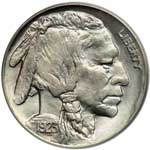 |
1923-S. PCGS graded MS-65. CAC Approved PQ. Housed in an Old Green Holder. Better than average strike. Mostly untoned. To see this coin is to fall in love with it. When we count all its virtues we find that the result is tantamount to making this a "must have" 1923-S Nickel for the specialist. To begin we might as well describe it as being well struck, deeply lustrous, and with full brilliance undiminished by toning, with the mint bloom evenly distributed on both sides and silvery bright. Among the marvelous gems in this collection, although it is unfair of us to chose one from the others, this is certainly among the most important in terms of eye-appeal and consequent beauty. Pop 39; 3 finer, 1 in 65+, 2 in 66 (PCGS # 3950) .
Historic Note: The years 1921 through 1923 witnessed interrupted production of minor coinage after the economy readjusted to peacetime conditions following the end of the Great War in 1918. In 1921 San Francisco made no dimes, and Denver made no cents or nickels; neither mint made quarters. In 1922 only the Denver Mint, struck cents. There were no other minor coins produced during the year. In 1923, Philadelphia and San Francisco returned to more normal production, but Denver was assigned only dollar coinage in the silver, copper, and nickel coin production cycle. Each denomination that San Francisco struck in 1923, from cent to half dollar (and it minted all the minor coins this year) is scarce to rare in Gem condition. Date and mint collecting had not developed as yet. And hoarders tended to go with P-mint issues for some reason, possibly due to the larger East Coast population back then. Original rolls of 1923-S coinage, let alone bag quantities (except for silver dollars) were unheard of.
Estimated Value $9,000 - 10,000.
View details and enlarged photos
Check results on similar lots
| Realized
$26,450 |
Lot 1187 |
 |
1924. PCGS graded MS-65. CAC Approved PQ. Housed in an Old Green Holder. A hint of gold tone. Another lustrous P-mint example of this higher mintage date, a coin untoned and showing razor-like detail; excellent nickel-silver color. Pop 209; 84 finer, 3 in 65+, 77 in 66, 4 in 67 (PCGS # 3951) .
Estimated Value $700 - 750.
View details and enlarged photos
Check results on similar lots
| Realized
$1,495 |
Lot 1188 |
 |
1924-D. PCGS graded MS-65. CAC Approved PQ. Well struck with lovely golden toning. Should be graded one point higher.A very attractive gem with vibrant surfaces that burst out atop the fresh and hard-working luster throughout. Some weak spots in strike is seen only at the buffalo�s forehead and top of the shoulder. These are the two highest areas on the reverse and lie opposite similar relief portions on the obverse. Bold for this typically weak D-mint release of 1924.
The 1924-D is the first Denver Mint Buffalo Nickel produced since 1920. Apparently, there was no demand for new Nickels in that part of the country in 1921, 1922, or 1923. The '24-D (5.2 million pieces) probably saw widespread circulation at the time of issue, but it is still among the more frequently offered mintmarked issues of the 1920s in lesser Mint State grades. That being said, since strike is a problem for this date, collectors will often experience difficulty locating an attractive Gem Mint State 65 representative. We strongly recommend, therefore, a firm bid on the present lot. Pop 97; 2 finer in 66 (PCGS # 3952) .
Estimated Value $4,200 - 4,400.
View details and enlarged photos
Check results on similar lots
| Realized
$20,125 |
Lot 1189 |
 |
1924-S. PCGS graded MS-65. CAC Approved PQ. Housed in a First Generation Holder. Lovely rich golden toning. Well struck and very impressive. A definite highlight of the sale, this is a truly memorable 1924-S Nickel that stands as one of the freshest, most captivating Gem survivors of this key-date issue. The obverse and reverse are flooded in crescents of extremely vivid luster that gives way to lighter golden iridescence over the balance of the surfaces. Impressively sharp in the striking category, neither side reveals what we would classify as distracting or otherwise memorable lack of detail. Smooth and satiny, with the strongest eye appeal that this cataloger has seen in a long while in a '24-S Buffalo. Original mintage: 1.4 million pieces, most of which were poorly struck. Almost all have long since been worn out in circulation. Pop 34; 1 finer in 66 (PCGS # 3953) .
An immediate question that arises from collectors when first learning about the Buffalo nickel is who is depicted on the obverse. Pressed for an answer, designer James Earle Fraser eventually felt compelled to respond when he said the names of Iron Tail, a Sioux, and Two Moons, a Cheyenne, as being among the three models engaged. His memory failed him on the identity of the third, but the most reliable evidence suggests that the third model was Big Tree, a Kiowa.
Estimated Value $11,000 - 12,000.
View details and enlarged photos
Check results on similar lots
| Realized
$32,200 |
Lot 1190 |
 |
1925. PCGS graded MS-65. CAC Approved PQ. Boldly struck with lovely toning on both sides (PCGS # 3954) .
Historic associations: During 1925, a real estate investing boom occurred in the state of Florida that rivaled, and in many ways surpassed, the California real estate boom of 1887. At its height, prices for some of the tonier lots in Miami eclipsed the figure of a similar plot in New York: for instance, the sale of a Miami property for more than $300 a front foot eclipsed the $212 figure for a plot at the northwest corner of Forty-fourth Street and Fifty Avenue in New York City. (Reminder: these prices are GOLD STANDARD dollars, worth many times these figures in today's currency.).
Estimated Value $450 - 500.
View details and enlarged photos
Check results on similar lots
| Realized
$575 |
Lot 1191 |
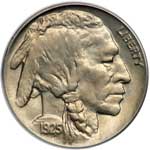 |
1925-D. PCGS graded MS-65. Housed in an Old Green Holder. Nice even toning. A leading strike and condition rarity in the Buffalo series, the 1925-D is just as challenging in the opinion of many in the finest Mint State grades as the 1919-D, 1919-S, 1920-S, 1925-S and 1926-D. One can imagine our delight, then, at being able to present this premium-quality Gem from this collection to the advanced Buffalo Nickel collectors among our bidders. A coin that clearly resides front and center within its grade class, both sides are very well struck for the issue with overall clear if not quite razor-sharp definition. We further draw attention to surfaces that are fully lustrous, satiny in sheen and silent on the subject of grade-limiting marks. Thus, a whole range of positive attributes that will guide bidders when estimating their bid level for this '25-D Nickel. High Condition Census coin! Pop 78; 7 finer in 66 (PCGS # 3955) .
Estimated Value $4,500 - 5,000.
View details and enlarged photos
Check results on similar lots
| Realized
$7,475 |
|
|